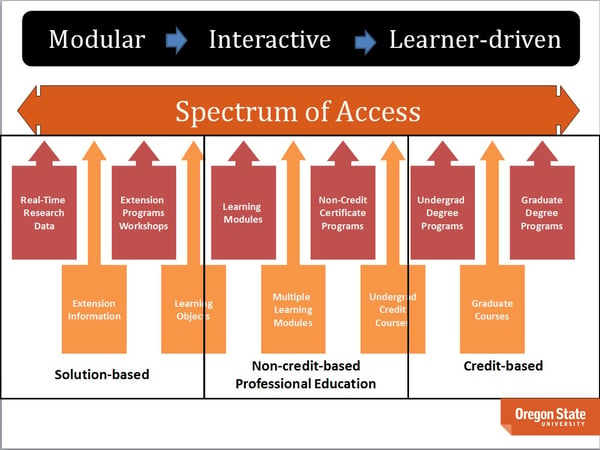Published on
Honing a Spectrum of Learner Access

Creating access for learners across a seamless spectrum of learning opportunities is a valuable exercise for higher education leaders. It allows us to better understand the different populations accessing our institutions. There are some similarities in the expectations and characteristics of learners that hold true at every point across the spectrum. However, each sector on the spectrum has its own unique demands that we must meet in order to provide the experience that brings learners back for more.
In this piece I will explore some of these expectations and demands in more detail, discussing the demands of learners at multiple points across our Spectrum of Access and shedding some light on what it might take for institutions to actually meet the expectations of such a wide array of learners.
Shared Values: Factors Learners Define as Value-Adding Across the Spectrum
The most obvious factor that learners Spectrum-wide see as valuable is academic quality. That almost goes without saying, but it needs to be kept at the top of the list even though it is what we assume from all our institutions.
Beyond that, though, I would say there are three things: responsiveness, credibility and context.
These factors are very interactive. In many cases, learners expect our programs to be responsive to their unique needs. They also expect us to bring them to credible outcomes that decision-makers in their professional lives will perceive as valuable. Finally, they expect their learning opportunities to be in context to the needs they face on a daily basis.
From a structural side, it’s why we suggest right up front in the Spectrum of Access that learning opportunities should be modular, interactive and learner-driven.

Exploring the Distinct Value-Adding Factors Across the Spectrum of Access
The Solution-Based Sector
In this sector, the main issue for learners is personalized solutions to the problems they face. This is where access to the knowledge base of the university needs to be personalized and individually focused. This doesn’t mean that we have to take everyone on face-to-face and individually. Instead, it means that the needs of the learner should be uniquely segmented and identified in ways that, although we are providing access to a relatively large group of people, each is coming to our access point and getting something to address the issue they face.
This could mean everything from focused workshops and online modules that can be assembled to meet their unique needs, to an Ask an Expert system where learners can email requests for solutions that are answered in 48 hours or less.
The Non-Credit-Based Professional Education Sector
Professional non-credit learners tend to come to us looking for ways to be better at their jobs tomorrow. Many need credentials of some sort. Micro-credentials such as badges and certificates that will demonstrate some level of competency can be critical, but in many cases simply being a better decision maker or understanding factors that lead to success are as important. And all of this must clearly fall under the umbrella of the three areas mentioned above: responsiveness, credibility and context. Professional non-credit learners hold our feet to the fire on these three factors. If we aren’t directly responsive to their needs with a credible product that can be seen in the unique context of their professional lives, they will go somewhere else.
The Credit-Based Sector
On the credit side, to be successful we need to understand as clearly as in the other sectors who our real learner audience is. That means setting aside the 18-year old kegger-going, sorority-pledging, straight-out-of-high-school image.
Anywhere from 70 to 85 percent of our current student population on campus doesn’t fit that image anymore. They are working full or part time, going to school full or part time and in many cases caring for a dependent. Our off-campus learners can lead even more complicated lives. They all understand as well as anyone why they have decided to make the sacrifices needed to return to their education. So here—as much as anywhere—we are expected to provide access to affordable learning opportunities that lead to high-quality credentials but at the same time are totally responsive to the challenges they face every day at work.
Evolving To Meet the Academic Needs of Learners Across the Spectrum of Access
The first step to ensuring we are meeting the academic needs of students Spectrum-wide is recognizing the need to create seamless links across the sectors. Each of the three sectors carries its own level of inherent culture that can be difficult to connect. Working in a more modular fashion within each sector opens the opportunity for linking without forcing some of the more entrenched players to cross over. MIT is actively promoting this within their colleges and departments. Modular course development gives the coalition of the willing—those ready to make the connections—a foundation from which to work. Using learning modules from others still tends to be off-putting to some. Some people call it the toothbrush syndrome—everyone knows they are useful; everyone knows they are necessary; everyone wants one; no one wants to use someone else’s.
Addressing Competitiveness Across the First Two Sectors of the Spectrum of Access
The solution-based and non-credit professional education segments of the Spectrum can be as competitive or collaborative as the players involved make them. I’ve found that there is a knife-edge difference between competition and collaboration. The functions or the parts of the university that are placed in these juxtapositions are typically (and maybe by definition) focused on similar outcomes. It really comes down to offering access to the learners across the spectrum and making sure they can choose as they see fit to meet their needs.
Typically at the outer ends of the two sectors, there are unique learner options. However, at the intersection of solution-based and professional non-credit, the marketplace may control who serves whom and how well. This is not a bad thing. It means the faculty involved in either side of the intersection will be more likely to actively monitor the evolving needs of the learners.
Ultimately, a great consumer experience is critical at any spot on the Spectrum. The fact that the typical learners along the first two sectors of the spectrum don’t include many straight-out-of-high-school 18-year-olds may mean that they have no wiggle room when it comes to meeting learner needs in a responsive, credible and contextual fashion.
However, in the current learner environment we cannot afford to be any less focused on the great consumer experience anywhere. The importance of the seamless spectrum approach is that the learner can find that sweet spot that offers them exactly what they need when they need it. They will demand of us that great consumer experience at every learning opportunity available to them.
Transforming the Business Model to Meet the Expectations of Today’s Learners
Now we come to the real motivator of change—money. It not easy, because we have been doing things the way we have for so many decades and centuries, but the critical factor appears to me to make sure the money follows the learner. The business model should reward those who are clearly successful in meeting learner needs in a long-term and sustainable fashion. Solution-oriented, professional non-credit and credit based should in some way be similarly responsive to the ultimate goal of learner success. Fees, registration revenue, tuition all should be in some way linked to learner success no matter where on the spectrum that learner lands. In reality what success looks like across the spectrum can be measured differently, so some level of commonality in the overall business model can be valuable but allowing for the uniqueness of each instance is as critical.
We’ve discussed three strategies in this piece, each applicable to their own sectors on the Spectrum:
- Making solution-based program funding more competitive;
- Maintaining the direct connection between learner success and fees in professional non-credit;
- Aligning direct access to tuition revenue based on student credit hours generated in credit programming.
These are all fundamentally similar approaches that will help the players recognize the need to create more effective links across the spectrum to be successful in their sector.
Author Perspective: Administrator



